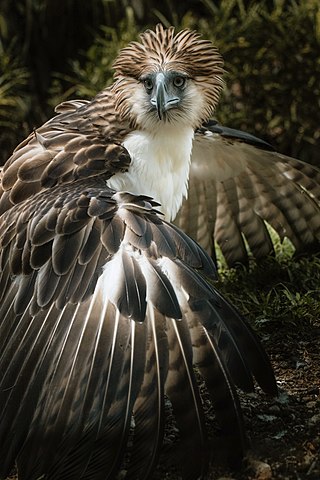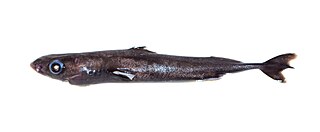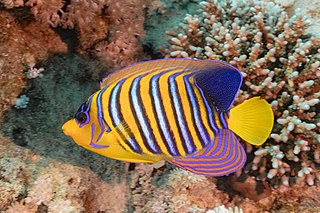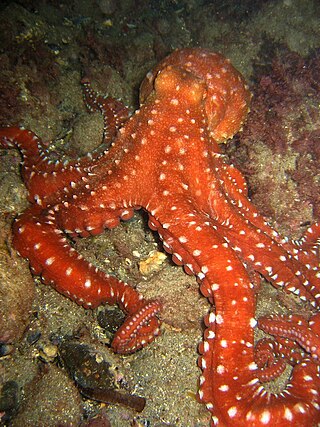
The Philippine eagle, also known as the monkey-eating eagle or great Philippine eagle, is a critically endangered species of eagle of the family Accipitridae which is endemic to forests in the Philippines. It has brown and white-colored plumage, a shaggy crest, and generally measures 86 to 102 cm in length and weighs 4.04 to 8.0 kg.

The milkfish is a widespread species of ray-finned fish found throughout the Indo-Pacific. It is the sole living species in the family Chanidae, and the only living member of the genus Chanos. The repeating scientific name (tautonym) is from Greek khanos.

The Octopodidae comprise the family containing the majority of known octopus species.

The gummy shark, also known as the Australian smooth hound, flake, sweet william or smooth dog-shark, is a species of ground shark in the genus Mustelus of the family Triakidae. These small to medium-sized bottom-dwelling sharks are found mostly in, but are not limited to, the area around the southern seas of Australia and is commonly baited and fished for cuisine because of its taste and market prices. According to a 2021 paper by White, Arunrugstichai & Naylorn (2021), Mustelus walkeri is the same animal as M. antarcticus. One theory is that M. walkeri is a subpopulation of M. antarcticus.

Octopus is the largest genus of octopuses, comprising about 100 species. These species are widespread throughout the world's oceans. Many species formerly placed in the genus Octopus are now assigned to other genera within the family. The octopus has 8 arms, averaging 20 cm (8 in) long for an adult.

The smalleye pygmy shark is a little-known species of squaliform shark in the family Dalatiidae, found in water 150–2,000 m (490–6,560 ft) deep near Japan, the Philippines, and Australia. It migrates vertically daily, spending the day in deep water and the night in shallower water. One of the smallest shark species, the smalleye pygmy shark is known to reach only 22 cm (8.7 in) long. It has a blackish, spindle-shaped body with relatively small eyes, and a spine preceding the first dorsal fin, but not the second. Bioluminescent photophores occur on its underside, which may serve to disguise its silhouette from predators. This species feeds on small squid, krill, shrimp, and bony fishes. It is aplacental viviparous. The International Union for Conservation of Nature has assessed it as Least Concern, citing its wide distribution and lack of threat from fisheries.

The starry sturgeon, also known as the stellate sturgeon or sevruga, is a species of sturgeon. It is native to the Black, Azov, Caspian and Aegean sea basins, but it has been extirpated from the last and it is predicted that the remaining natural population will follow soon due to overfishing.

The Kidako moray is a species of marine fish in the family Muraenidae. It inhabits coral reefs or lagoons and could be found in tropical and subtropical seas near Taiwan, Japan, and Australia. The species is diurnal, which means it is more active in the daytime than the nighttime. It is also piscivorous: it consumes fish, octopus, and squid. Other than the Kidako moray, there are about 200 species of moray eels in the Muraenidae family. The Kidako moray would not attack humans unless they are provoked. However, due to the menacing looks of the Kidako moray and moray eels in general, they are feared by divers and snorkelers.

Gymnopilus junonius is a type of mushroom-forming fungus in the family Hymenogastraceae. Commonly known as the spectacular rustgill, this large orange mushroom is typically found growing on tree stumps, logs, or tree bases. Some subspecies of this mushroom contain the neurotoxic oligoisoprenoid gymnopilin.

The royal angelfish, or regal angelfish, is a species of marine ray-finned fish, a marine angelfish belonging to the family Pomacanthidae, and the monotypic genus Pygoplites. It is found in tropical Indo-Pacific oceans. It can grow as long as 25 cm (9.8 in).

The black-banded sea krait, also known commonly as the Chinese sea snake, is a largely amphibious species of venomous marine reptile in the subfamily Laticaudinae, family Elapidae. It is found in much of the western Pacific Ocean and some of the Sea of Japan. In Japan, it is known as erabu umi hebi ; in Okinawa, it is known simply as irabu.

The starry night harlequin toad is a species of toad in the family Bufonidae endemic to the Sierra Nevada de Santa Marta, Colombia. Its natural habitats are sub-Andean and Andean forests, sub-páramo and páramo at 2,000–3,500 m (6,600–11,500 ft) above sea level. It is named after its unique coloration, being largely black with white spots.

The Pribilof Island shrew is a small, short tailed species of mammal in the family Soricidae (shrews). It is endemic to and found only on Alaska's Pribilof Islands. Due to its distinct tricoloured coat, it was originally thought to be related to the Arctic shrew, but it is in fact much closer to the Cinereus shrew in its geographical distribution and morphological traits. Not much is known about the population size, breeding habits, ecology, and the general biology of the shrew.

Callistoctopus macropus, also known as the Atlantic white-spotted octopus, white-spotted octopus, grass octopus or grass scuttle, is a species of octopus found in shallow areas of the Mediterranean Sea, the warmer parts of the eastern and western Atlantic Ocean, the Caribbean Sea, and the Indo-Pacific region. This octopus feeds on small organisms which lurk among the branches of corals.

The starry rockfish, also known as the spotted corsair, spotted rockfish, chinafish, and red rock cod, is a species of marine ray-finned fish belonging to the subfamily Sebastinae, the rockfishes, part of the family Scorpaenidae. It is found in the eastern Pacific Ocean.

Callistoctopus ornatus is a tropical species of octopus native to the Indo-Pacific region. Other common names include white-striped octopus and night octopus, in reference to its nocturnal habits. It was previously known as Polypus ornatus. C. ornatus is edible and was recorded in a Hawaiian market in 1914 by S. S. Berry.

Callistoctopus is a genus of nocturnal, orange octopuses in the family Octopodidae. They are readily identifiable by their reddish coloring, the white papillae that line their bodies, and their long arms. Though sympatric with diurnal Octopus species, they avoid competition by hunting at night. In acknowledgement of this preference, many species of Callistoctopus are referred to as night octopuses. Well-known species include C. macropus and the type species C. ornatus, both of which are harvested for human consumption as seafood.
Marsha's lanternshark is a species of shark in the family Etmopteridae. It is found in the Western Pacific near the Philippines and can reach 23.4 cm in length.
Callistoctopus bunurong, the southern white-spot octopus, is a species of octopus in the family Octopodidae, that can be found in Australia waters at depths of 1 to 130 meters on sandy substrates. It was originally placed in the genus Octopus, having the scientific name Octopus bunurong, but has been moved to the genus Callistoctopus.

Callistoctopus rapanui, or the rapanui octopus, is the only endemic octopus species in Rapa Nui. It was first described by Gilbert L. Voss in 1979 as Octopus rapanui.


















